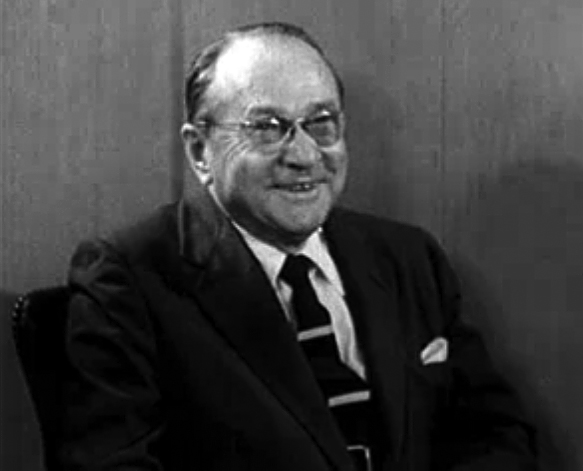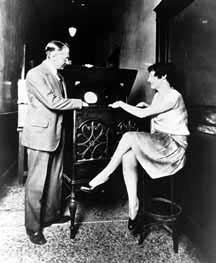 |
| Vladmir Zworykin Unknown author / [Public domain] via Wikimedia |
Vladimir Kosma Zworykin has been called "The Father of Television," though there were hundreds, if not thousands of individuals involved in the slow, methodical process of putting together the pieces until they worked. Zworykin's younger contemporary, Philo Farnsworth, also shared major credit in television’s birth, as did Zworykin's beloved Russian physics teacher, Boris Rozing, a Scotsman Alan Archibald Campbell Swinton, and many other inventors and scientists of the time. David Sarnoff, head of RCA, had a vision of bringing television into the home. He chose and supported Zworykin as the man who would create the technology for electronic television. What matters most is not that Zworykin was given the credit, but that he was the kind of scientist who followed his passion over a lifetime and made the best of his good luck.
Vladimir Kosma Zworykin was born in Murom, Russia, (about 200 miles east of Moscow) on July 30, 1889, the youngest of 7 children. Murom was a successful center of commerce, and Vladimir’s father, Kosma, was an educated well-to-do merchant who owned and operated a fleet of riverboats on the Oka River. He was frequently away on business, leaving the running of the big family to mother Elana. Vladimir grew up in a big mansion and had a carefree childhood, full of orchestrating practical jokes, doing well in school, and hiking and playing in the nearby woods. Because his older brothers showed no interest, Vladimir's father took him on trips to learn the family business.
In the early 1900's, life was changing in Russia. There was general dissatisfaction with the tsarist government, with rampant corruption and no freedom. The ruling class had all the wealth and power, leaving the average Russian to live in terrible conditions.
In 1911, while revolution was brewing, Zworykin studied at the St. Petersburg Institute of Technology. He worked in the private lab of Professor Boris Rozing, who introduced him to the cathode ray tube and the theoretical dream of “electrical telescop.” Rozing had already built his first television device, and Zworykin spent most of his free time helping with the experiments. German, French and American scientists also were busy at work experimenting and obtaining patents for various parts of the television puzzle. When he graduated with an engineering diploma in 1912, the equipment needed for a working television still had not been developed. Zworykin wanted to continue helping Rozing, but Zworykin’s father wanted him to help run the family business. Vladimir convinced his father to let him continue his studies in France at the College de France in Paris, where he studied X-rays under Professor Paul Langevin, a prominent French theoretical physicist who eventually won a Nobel Prize. In 1914, the threat of war put an end to Zworykin’s studies and he returned to Russia.
 |
| A 1930 demonstration of electronic television Smithsonian Institution Archives [Public Domain] |
During World War I, Zworykin's expertise in wireless transmission got him assigned to work with the Marconi Company and gave him access to the latest in radio equipment, including improved high-vacuum amplifying tubes. He also met and married his wife, Tatiana Vasilieff. He wanted to join Marconi's Russian branch after the war, but world events ruined his plans.
In early 1917, after great civil unrest, Tsar Nicholas II abdicated and power shifted to the Russian parliament. In October, the Bolsheviks overthrew the provisional government. Zworykin wanted to stay out of the civil war he saw coming, so he avoided signing up for the Red Army. An order for his arrest was announced, and Zworykin's friends helped him escape. After a year and a half of hard work, on January 1, 1919, Vladimir Zworykin arrived in America. Eventually he found work at the Westinghouse unit of the Radio Corporation of America (RCA). He was able to buy a house, and his wife joined him.
Zworykin received a patent for the kinescope, the first television picture tube, in 1923. The next year he became a United States citizen and enrolled at the University of Pittsburgh where he received a Ph.D. His efforts to build and operate a cathode-ray television system started sometime in June 1924. The Westinghouse Electric laboratory made Zworykin's project a high priority, and he was able to purchase equipment and hire staff to move the work along more quickly. However, the project was taken away from him, and he learned an important lesson: commercial research required profitability.
In 1929, he was transferred to RCA by David Sarnoff, the company's president, and given his own lab in California. Zworykin filed his patent for color television that year, and Sarnoff gave him as much money as he said he needed, even during the Depression, when other departments were being closed. During the 1930s and 1940s, RCA spent more than $50 million on the development of television.
Zworykin's television system used a high-voltage cathode-ray tube and presented a 5-inch image that was bright enough to be viewed in a well-lit room. At this time, Philo Farnsworth's system was also well developed, but his image was limited to a blurry 2 inches. Zworykin visited Farnsworth's lab and was given a complete tour and description of Farnsworth's work. Farnsworth hoped that Zworykin, representing RCA, would provide critical funding. The two men reportedly got along very well, both appreciating the inventions of the other. However, Zworykin’s supervisors at RCA decided they didn't need to buy Farnsworth's patents or system. Farnsworth's work, especially the higher quality dissector tube, gave Zworykin ideas to improve his own 2-sided picture tube.
As more and more scientists around the world approached a working model of a television system, patent wars raged. Business managers, attorneys and legislative officials fought it out in courts, the Patent office, and in boardrooms. Sarnoff made sure Zworykin had everything he needed, including buying up television patents internationally so Zworykin would have the greatest chance of success. RCA kept its work on television as secret as possible
In 1931, Sarnoff tried to buy Farnsworth's company, especially for its alternate camera tube, the only other one in existence. He lost out to another company, Philco, and from that time on there was intense rivalry between Farnsworth and RCA, with battles in the U.S. Patent Office, where RCA tried to get control of the dissector tube.
Zworykin was always open to suggestions from his co-workers. As a result, he was able to produce his other great invention, a practical camera tube that vastly improved his television system. He called it the iconoscope from the Greek icon meaning 'image' and scope meaning 'observing'.
RCA began publicizing its progress with television when the world was in the depths of the Depression, but it did so slowly, wanting to keep from competing with radio, which was still the only profitable part of its organization. Finally, in June 1933, Zworykin presented a complete description of his television system during the Chicago World’s Fair before the Institute of Radio Engineers. The New York Times put the story on its front page, and people thought television was just around the corner. Zworykin stated, "The fate of television now rests in the laps of the financial and merchandising experts." David Sarnoff was on his way to realize his dream of putting a television in every home, but people were still going to have to wait for awhile.
Zworykin returned to Russia several times, where he was well received, lecturing throughout the country on television and helping them purchase a complete working system from RCA.
Zworykin turned his attention to new inventions, including work on the electron microscope. During World War II, Zworykin developed a camera a hundred times more powerful than the iconoscope, which was the first night-vision camera, called the sniperscope or snooperscope, and he worked on radio-controlled missiles. Technology from the night vision camera led to a new tool for measuring radioactivity, the scintillation counter. Zworykin also worked with the mathematician John Von Neumann on the early development of the computer, using vacuum-tube technology.
Retiring from RCA in 1954, Zworykin continued work in his own laboratory. He created the endoradiosonde, a tiny transmitter that was swallowed to let doctors monitor processes inside the body. The ultraviolet microscope was another of his inventions. He was given many awards, including the National Medal of Science in 1967. This is the highest scientific honor given in the United States. In 1977, he was inducted into the National Inventors Hall of Fame.
Zworykin was very ambivalent about how his invention developed into modern day television. He had envisioned a way of bringing culture and education to all people and was distressed at the violence and crime. He didn't think television was good for children and once quipped that the best thing about television was "the off switch." Nevertheless, he was proud of television's positive effects in areas ranging from politics to news to transportation.
Vladimir Zworykin died of old age July 29, 1982.
On the 100th anniversary of Zworykin's birthday in 1989, Voyager 2 sent back television pictures of the Planet Neptune and its moon Triton using vidicon cameras which grew out of the work of Zworykin and RCA.
Page created on 7/18/2004 6:04:14 PM
Last edited 7/29/2020 7:22:59 AM
Additional references:
The Scribner Encyclopedia of American Lives, Volume 1: 1981-1985. Charles Scribner's Sons, 1998. Reproduced in Biography Resource Center. Farmington Hills, Mich.: The Gale Group. 2002. (http://galenet.galegroup.com/servlet/BioRC)
American Decades CD-ROM. Gale Research, 1998. Reproduced in Biography Resource Center. Farmington Hills, Mich.: The Gale Group. 2002. (http://galenet.galegroup.com/servlet/BioRC)
